Kenneth Branagh's "HAMLET" on 65mm |
Read more at in70mm.com The 70mm Newsletter |
| Written by: Eastman Kodak Professional Motion Imaging, 1996. Prepared for in70mm.com by Anders M. Olsson, Lund, Sweden | Date: 09.08.2013 |
"I could a tale unfold whose lightest word would harrow up thy soul..."
|
|
 "I've been fascinated by Hamlet ever since I saw Richard Chamberlain playing
the title role in a TV production around 1972. The man in black intrigued
me. The poetic power of the play overwhelmed me. I was struck by its
emotional force. Hamlet is an extraordinary canvas. It deals with the
personal - families and family problems, which all can empathize with - and
epic, because it also concerns the fate of a country. "I've been fascinated by Hamlet ever since I saw Richard Chamberlain playing
the title role in a TV production around 1972. The man in black intrigued
me. The poetic power of the play overwhelmed me. I was struck by its
emotional force. Hamlet is an extraordinary canvas. It deals with the
personal - families and family problems, which all can empathize with - and
epic, because it also concerns the fate of a country. Hamlet remains worthy of a full-blooded, big screen treatment. This is our attempt to bring together the best crew, the best actors and, for the first time with any Shakespeare film, the full version of the text. A Hamlet that our children can watch, enjoy and debate. Such a film deserved to be made in 65mm. Pictures I've seen in that format are uniquely involving. They make you feel as though you can walk right into the landscape. I wanted Hamlet to have the same visceral element. I wanted the audience to smell and feel the atmosphere of the court, dripping with power, opulence and corruption. The increased sharpness of 65mm picks up everything; not just facial expressions, but any meaning in the actor's eyes is caught that much more clearly. It probes more deeply into the inner life of the character. It makes a significant impact on the power of the film, and therefore on its potential to reach a large audience. It gives a big picture feel to it, very much removed from watching films on small multiplex cinema screens or on video. I like to go to the movies. I like a large cinema with a packed house and a big picture. That to me is a very distinctive form of entertainment. And I wanted to be involved with that." KENNETH BRANAGH DIRECTOR |
More in 70mm reading: 2013: A Danish Summer of 70mm "Hamlet" to be filmed in 70mm Release of "Hamlet" in 70mm Readers Reviews of "Hamlet" ”Hamlet” in 70mm at Kronborg Castle 70MM "Hamlet" in Ireland “Hamlet”: The North American 70mm Engagements |
"A hit, a very palpable hit"
|
|
 The Ingredients of a Classic Film. The Ingredients of a Classic Film.Classic feature films such as "Gone With the Wind", "The Third Man", "The Godfather", "Platoon" and "The Last Emperor" all contain common ingredients. A good story, brilliant direction, outstanding acting and the best possible photography. Others like "Lawrence of Arabia" and "Ryan's Daughter" have an added ingredient, in terms of picture quality. And so does Kenneth Branagh's "Hamlet", because it, like the last two, was filmed on 65mm. A visual comparison of a 35mm frame with a 65mm frame clearly shows the advantages of the larger format. Each frame contains nearly four times as much picture information as a similar scene shot on 35mm. Imagine what that means in image quality. Let's mix the ingredients. The story. Shakespeare's greatest play. The director. Already a celebrated actor, Branagh's talents as a film director burst onto our cinema screens in 1988 with his stunning adaptation of the award winning Henry V. The acting. For Hamlet, Branagh assembled an unusually talented, eager and open-minded cast of dedicated international performers. The photography. The filming of this epic was entrusted to a most distinguished and respected Director of Photography - Alex Thomson, BSC, who has been making outstanding films for nearly 50 years. Picture quality. The last major ingredient is Kodak motion picture film, the preferred choice of leading filmmakers for over 100 years. A 100 years of continuing advances in Kodak emulsion-making technology. Improvements like the development of films with extended range, ultra latitude, superb intercuttability...and now the new family of Kodak Vision films. With their unique T-grain structure for an improved speed-grain relationship and sharpness, these new films bring images of unsurpassed quality to modern cinema. And for those who aim for the ultimate quality there is Kodak 65mm motion picture film. For Kenneth Branagh there was no other choice. |
|
What The Filmmakers Said |
|
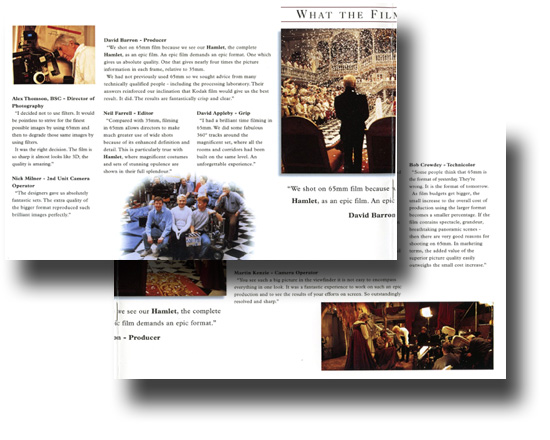 David Barron - Producer David Barron - Producer"We shot on 65mm film because we see our "Hamlet", the complete Hamlet, as an epic film. An epic film demands an epic format. One which gives us absolute quality. One that gives nearly four times the picture information in each frame, relative to 35mm. We had not previously used 65mm so we sought advice from many technically qualified people - including the processing laboratory. Their answers reinforced our inclination that Kodak film would give us the best result. It did. The results are fantastically crisp and clear." Alex Thomson, BSC - Director of Photography "I decided not to use filters. It would be pointless to strive for the finest possible images by using 65mm and then to degrade those same images by using filters. It was the right decision. The film is so sharp it almost looks like 3D; the quality is amazing." Nick Milner - 2nd Unit Camera Operator "The designers gave us absolutely fantastic sets. The extra quality of the bigger format reproduced such brilliant images perfectly." Neil Farrell - Editor "Compared with 35mm, filming in 65mm allows directors to make much greater use of wide shots because of its enhanced definition and detail. This is particularly true with Hamlet, where magnificent costumes and sets of stunning opulence are shown in their full splendour." David Appleby - Grip "I had a brilliant time filming in 65mm. We did some fabulous 360° tracks around the magnificent set, where all the rooms and corridors had been built on the same level. An unforgettable experience." |
|
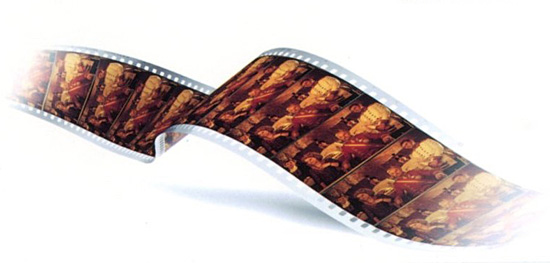 Antony Hunt - SFX, Magic Camera Company Antony Hunt - SFX, Magic Camera Company"We made our traditional matte paintings about twice the normal size and filmed them on 65mm 5293. When cloning soldiers digitally in the bigger format we needed a lot more storage and computer memory. Otherwise making SFX for 65mm is essentially the same as for 35mm. It is only the superior finished quality that highlights the differences!" Chyna Thomson - Focus-puller "Filming in 65mm sharpens the mind of the focus-puller unbelievably! On close-ups there is little depth of field to work with. And Kenneth made us push the boundaries of film making to extremes. We did the most incredible close-ups - despite the lack of depth. But 65mm is beautiful. You see so much more colour; so much more detail in the actors and their costumes. It's a wonderful format." Martin Kenzie - Camera Operator "You see such a big picture in the viewfinder it is not easy to encompass everything in one look. It was a fantastic experience to work on such an epic production and to see the results of your efforts on screen. So outstandingly resolved and sharp." Bob Crowdey - Technicolor "Some people think that 65mm is the format of yesterday. They're wrong. It is the format of tomorrow. As film budgets get bigger, the small increase to the overall cost of production using the larger format becomes a smaller percentage. If the film contains spectacle, grandeur, breathtaking panoramic scenes - then there are very good reasons for shooting on 65mm. In marketing terms, the added value of the superior picture quality easily outweighs the small cost increase." |
|
"Come, give us a taste of your quality"
|
|
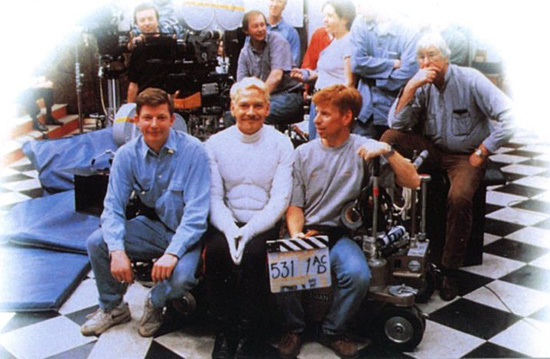 Filming in 65mm is very similar to filming in 35mm. Filming in 65mm is very similar to filming in 35mm.Film processing and postproduction in both formats is virtually identical - from original negative to final release prints. 65mm post work has a further stage - the production of 35mm optically reduced internegs for release prints to supply the 35mm theatre market. Special effects, whether optical or digital are created in the same way as 35mm SFX, except digital effects for 65mm usually require higher resolution to cover the larger negative area. Editing 65mm is done either from a workprint - optically reduced to 35mm - or digitally from a video screen. It becomes clear that, when comparing filming in 35mm and 65mm, the similarities far outweigh the differences. But there are some distinctions. The camera is larger; so is the film. A 1000ft reel of 35mm runs for around 10 minutes. A 1000ft reel of 65mm has a 20% shorter running time and it weighs nearly twice as much. The first camera assistant needs muscles! The longer focal length lenses needed to cover the wider 65mm format give less depth of field for any given aperture. In practice, that means filming at T5.6 with 65mm where you would be shooting at, say, T4.0 with 35mm. That is not a major problem on middle-distance or distant shots but it does make close-ups a little trickier. Get a first-class focus-puller and an excellent grip in your camera crew. They will earn their pay; spectacular close-ups beautifully filmed on 65mm can be dazzling. Go and see Branagh's "Hamlet" and judge for yourself. |
|
"This above all: to thine own self be true"
|
|
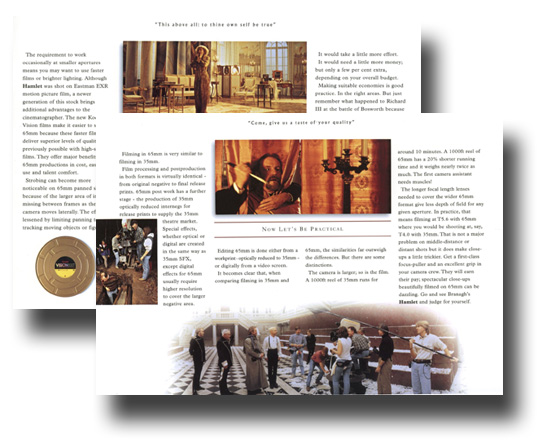 The requirement to work occasionally at smaller apertures means you may want
to use faster films or brighter lighting. Although "Hamlet" was shot
on Eastman EXR motion picture film, a newer generation of this stock brings
additional advantages to the cinematographer. The new Kodak Vision films
make it easier to shoot 65mm because these faster films deliver superior
levels of quality not previously possible with high-speed films. They offer
major benefits to 65mm productions in cost, ease of use and talent comfort. The requirement to work occasionally at smaller apertures means you may want
to use faster films or brighter lighting. Although "Hamlet" was shot
on Eastman EXR motion picture film, a newer generation of this stock brings
additional advantages to the cinematographer. The new Kodak Vision films
make it easier to shoot 65mm because these faster films deliver superior
levels of quality not previously possible with high-speed films. They offer
major benefits to 65mm productions in cost, ease of use and talent comfort.Strobing can become more noticeable on 65mm panned shots because of the larger area of image missing between frames as the camera moves laterally. The effect is lessened by limiting panning to tracking moving objects or figures. Briefly, these are the major differences between filming in 65mm compared with 35mm. Differences that, when balanced against other aspects of film making - like the weather on location or low flying aircraft - become relatively insignificant! We hope this short account of making Kenneth Branagh's "Hamlet" encourages other producers, directors and directors of photography to make films on 65mm. The bigger format will not turn the average film into a blockbuster. It will allow cinema audiences to see a potentially superb film made visually supreme. It would take a little more effort. It would need a little more money; but only a few per cent extra, depending on your overall budget. Making suitable economies is good practice. In the right areas. But just remember what happened to Richard III at the battle of Bosworth because he skimped on his horse's footwear! The battle for box office appeal is almost as crucial. "People are very discriminating when they go to the pictures. It's expensive to go to the cinema and they expect the film to look marvellous. When the print is lousy they are disappointed. But when the screen image looks marvellous - as it does on 65mm - it is so much richer and crisper than any other medium. It is a format that heightens the cinema experience and thrills the audience." KENNETH BRANAGH DIRECTOR |
|
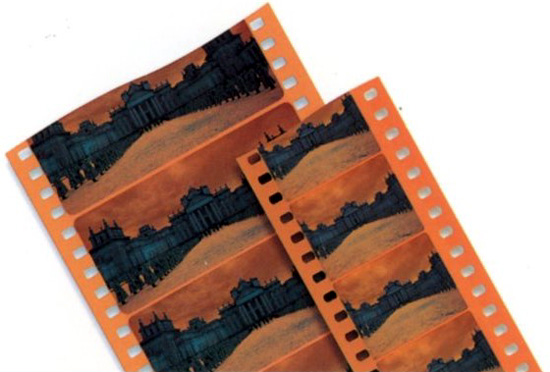 Professional Motion Imaging Professional Motion ImagingKodak Limited, PO Box 66 Station Road, Hemel Hempstead, Herts, HP1 1JU Telephone: 01442 845945 Fax: 01442 844458 Kodak Web address: WWW.KODAK.COM/GO/MOTION Photographs by Rolf Konow and Peter Mountain Hamlet is a Castle Rock Entertainment Presentation The Kodak device, Kodak, EXR, Vision and T-Grain are trade marks. Kodak Professional Motion Imaging H-192 |
|
|
Go: back - top - back issues - news index Updated 22-01-25 |
